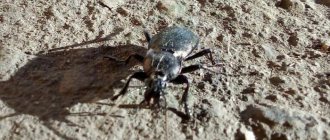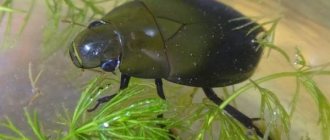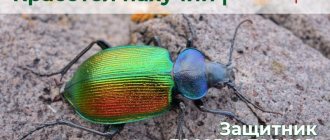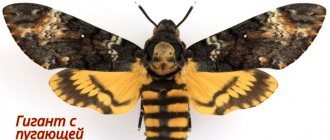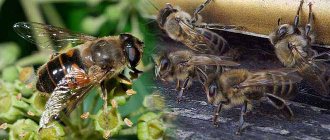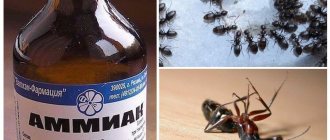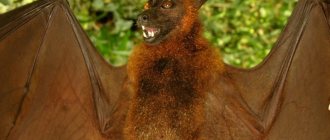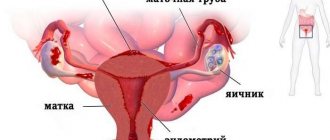| Caucasian ground beetle | |||||||||||||
| Scientific classification | |||||||||||||
Kingdom:
| |||||||||||||
| Latin name | |||||||||||||
| Сarabus (Procerus) caucasicus Adams, 1817 | |||||||||||||
| Caucasian ground beetle [1] (lat. |
Description
Morphology
The largest species of the genus Carabus in Russia. The length of the beetle is 32-55 mm. There are 2 subspecies common in Russia: the smaller (32-44 mm) C. c. caucasicus
and larger (45-55 mm)
C. c.
colchicus . Females are larger than males. Elytra with coarse, coarse-grained sculpture. The body color is blue, sometimes with a purple or green tint, and shiny. The anterior dorsum is noticeably narrowed in front, its anterior edge is narrower than the base, and the surface is roughly wrinkled or granular. The underside of the beetles' body is black, with a metallic sheen.
Biology
Beetles are active at various times of the day, but are most active at night. They are found throughout the growing season, starting in April. More active in spring and early summer. They run fast. Active predator. It feeds mainly on gastropods. Feeding on insect larvae and earthworms was also noted.
Nutrition
The Caucasian ground beetle is considered a predatory insect. In its diet you can find such species as:
- Larvae;
- Caterpillars;
- Aphids;
- Worms;
- Slugs and snails.
In order to catch and neutralize the victim, the beetle injects a special secretion, which is located in its jaw apparatus. This composition, once in the body of the prey, liquefies its internal organs, as a result of which the beetle can calmly feast on its find. The process of digesting the food of this representative can take several days, during which time it returns to the shelter, where it spends time until the next hunt. Hunting occurs mainly at night.
Habitat
The nominate subspecies is distributed in relatively dry forest communities, mainly oak forests. Sometimes it rises to mountain steppes and meadow steppes at altitudes of 1800-2000 m above sea level. The second subspecies is mainly confined to deciduous and mixed forests in rocky and karst terrain.
Both subspecies can also be found in gardens and parks, and other cultural landscapes within their range.
The beetles are found on the soil surface, often in fallen leaves.
Distribution and protection
The Crimean ground beetle is protected in several regions. These are the Caucasian, Kabardino-Balkarian, Teberdinsky and North Ossetian reserves.
Due to droughts, forest fires, deforestation and constant use of pesticides, the number of large beneficial beetles has greatly decreased. They become victims of collectors and those who prepare decorations from flashy elytra.
At the moment, the Caucasian ground beetle can be found in some countries and regions:
- Iran;
- Türkiye;
- Caucasus;
- Transcaucasia;
- Dagestan;
- Adygea;
- Stavropol region;
- Krasnodar region;
- Georgia.
It has been proven that the order of Caucasian ground beetles can be more effective than treating an area with pesticides.
Notes
- Striganova B. R., Zakharov A. A.
Five-language dictionary of animal names: Insects (Latin-Russian-English-German-French) / Ed. Doctor of Biology sciences, prof. B. R. Striganova. - M.: RUSSO, 2000. - P. 103. - 1060 copies. — ISBN 5-88721-162-8.
| Red Data Book of Russia population is declining | |
| [www.sevin.ru/redbooksevin/search_both.html Search] on the IPEE RAS website |
The benefits and harms of ground beetles for humans
Ground beetles can be divided into two groups: harmful and beneficial. One of the dangerous species is the ground beetle. It belongs to the so-called category of poisonous beetles.
But poisonous not in the literal sense of the word. Its poison is a caustic chemical compound that is not capable of killing a person, but can cause allergic reactions in the form of rashes and swelling. A burn from such poison can last on the skin for about three days.
The ground beetle can cause serious damage to plants and damage household utensils and furniture. Thanks to its powerful jaws, the beetle can grind very hard material. The beetle causes serious damage to cereal plants, spoils indoor flowers by gnawing on roots, and easily reaches vegetable and berry crops.
This ground beetle is a nocturnal resident, so under the cover of darkness, while the owner is sleeping, it can climb onto bags of cereal, making holes in them. They easily allow themselves to climb onto the table in search of crumbs of food, without fear, they can crawl onto a person.
If such a beetle is found in the house - and you can recognize it by its characteristic dark purple color - you should immediately take action. To destroy the pest, modern chemicals are used, which can be purchased at any disinfection store. If you do not start fighting the beetle in time, its number can grow significantly, and then it will be much more difficult to get rid of uninvited residents.
But there are also positive aspects. Some types of beetles stand guard over the garden. These are the beauties, the Crimean ground beetle and the “tiger”. The favorite food of the Crimean ground beetle is the grape snail. This pest causes irreparable harm to grape crops and berries, spoils already ripe fruits, undermines the roots, which cannot recover and the plant dies.
Summer residents and gardeners are happy to see Krasotelov on their plots. It is thanks to the predatory skills of this beetle that the garden plots and crops are in perfect order. The beetle destroys all kinds of harmful pupae and insect larvae. Interestingly, ground beetle larvae are also hunters.
Due to their small size, they are not capable of destroying large insects, but they cope with small ones with a bang. Another interesting specimen is the tiger ground beetle. It is named so because the structure of its jaws resembles a tiger’s mouth with sharp, huge fangs.
With them he tears apart his prey. Insects that fall into the jaws of this beetle are doomed to death. The beetle lives in grass and between clods of earth. It is in constant search of food, so once you see it on your site, you can be calm about the safety of the harvest.
An excerpt characterizing the Caucasian ground beetle
“Add two more lines, it will be just like that,” he shouted in a thin voice, to which he tried to give a youthful appearance that did not suit his figure. - Second! – he squeaked. - Smash it, Medvedev! Bagration called out to the officer, and Tushin, with a timid and awkward movement, not at all in the way the military salutes, but in the way the priests bless, placing three fingers on the visor, approached the general. Although Tushin’s guns were intended to bombard the ravine, he fired with fire guns at the village of Shengraben, visible ahead, in front of which large masses of the French were advancing. No one ordered Tushin where or with what to shoot, and he, after consulting with his sergeant major Zakharchenko, for whom he had great respect, decided that it would be good to set the village on fire. "Fine!" Bagration said to the officer’s report and began to look around the entire battlefield opening before him, as if thinking something. The French came closest to the right side. Below the height at which the Kiev regiment stood, in the ravine of the river, the soul-grabbing rolling chatter of guns was heard, and much to the right, behind the dragoons, a retinue officer pointed out to the prince the French column encircling our flank. To the left, the horizon was limited to a nearby forest. Prince Bagration ordered two battalions from the center to go to the right for reinforcements. The retinue officer dared to notice to the prince that after these battalions left, the guns would be left without cover. Prince Bagration turned to the retinue officer and looked at him silently with dull eyes. It seemed to Prince Andrei that the retinue officer’s remark was fair and that there was really nothing to say. But at that time an adjutant from the regimental commander, who was in the ravine, rode up with the news that huge masses of French were coming down, that the regiment was upset and was retreating to the Kyiv grenadiers. Prince Bagration bowed his head as a sign of agreement and approval. He walked to the right and sent an adjutant to the dragoons with orders to attack the French. But the adjutant sent there arrived half an hour later with the news that the dragoon regimental commander had already retreated beyond the ravine, for strong fire was directed against him, and he was losing people in vain and therefore hurried the riflemen into the forest. - Fine! – said Bagration. While he was driving away from the battery, shots were also heard in the forest to the left, and since it was too far to the left flank to arrive on time himself, Prince Bagration sent Zherkov there to tell the senior general, the same one who represented the regiment to Kutuzov in Braunau to retreat as quickly as possible beyond the ravine, because the right flank will probably not be able to hold the enemy for long. About Tushin and the battalion covering him were forgotten. Prince Andrei carefully listened to the conversations of Prince Bagration with the commanders and to the orders given to them and was surprised to notice that no orders were given, and that Prince Bagration only tried to pretend that everything that was done by necessity, chance and the will of private commanders, that all this was done, although not on his orders, but in accordance with his intentions. Thanks to the tact shown by Prince Bagration, Prince Andrei noticed that, despite this randomness of events and their independence from the will of their superior, his presence did an enormous amount. The commanders, who approached Prince Bagration with upset faces, became calm, the soldiers and officers cheerfully greeted him and became more animated in his presence and, apparently, flaunted their courage in front of him.
Reproduction
Most insects do not live longer than a year, but the Caucasian ground beetle is an exception. The lifespan of the species reaches up to 3 years, and under good conditions it can live up to 5 years. The Caucasian ground beetle has all stages of complete transformation: egg, larva, pupa and adult. The breeding season for these individuals begins in the spring, usually from April to May. The female lays 70 eggs in just one clutch.
Caucasian beetles are very picky in choosing the place where their larvae will develop. Choose damp and warm soil into which sunlight does not penetrate. Before laying her eggs, the female digs a small hole at least three centimeters deep. The period of metamorphosis of an egg into a larva takes two or more weeks. The formed larva is up to 2 centimeters in length. For the first few hours, the larvae of the Caucasian ground beetle are white in color, but then they begin to darken until they turn black. The larvae spend time in this role until the end of the summer season, and live and feed in the same way as their adult companions.
In order to obtain food, the Caucasian ground beetle larva has a well-developed jaw apparatus, which is present in adult individuals. The transformation into a cocoon occurs at the beginning of autumn, and it becomes a fully formed Caucasian beetle only with the arrival of spring.
The Republic of Dagestan
Status: II category. A species that is declining in numbers.
Spreading
In Dagestan there are foothills.
Number
Rare everywhere. There is a tendency towards a decrease in the number of species everywhere
Source: Red Book of the Republic of Dagestan. Ed. Abdurakhmanov G.M., Magomedov B.I., Magomedov R.D., Sharipov A.R., Abdusamadov A.S. (2009) Makhachkala, Ministry of Natural Resources and Environmental Protection of the Republic of Dagestan
What does it eat?
The Crimean ground beetle is a carnivorous insect that feeds on terrestrial mollusks. The predator's diet includes:
- slugs;
- caterpillars;
- small beetles, their eggs and larvae.
The beetle's favorite delicacy is the grape snail. To eat a mollusk, the predator does not damage its shell; it places its head in its cavity and digs its powerful jaws into the meat of the prey, “drinking” it. A satiated ground beetle buries itself in the ground, where it can lie for several days.
On a note!
Crimean ground beetles bring great benefits to agricultural lands, protecting them from harmful insects.
Features and habitat
Coleoptera ground beetle, the description of a large family differs in the following characteristics:
- size;
- external structure;
- form;
- coloring;
- chaetotaxy – position of the bristles;
- structure of the genitals.
The ground beetle has other names: common, garden, forest. Sizes vary from the very minimum -1 mm to more than 10 cm. The body shape is also varied. In addition to the characteristic round with a biconvex or leaf-shaped lens, it contains an elongated or oval type.
The surface has a smooth, rough or coarse-grained structure. The cave species is similar in appearance to an ant, represented by a convex body with a deep constriction on the back and a huge head.
Cave beetle
Some species that inhabit sandy beaches resemble a ladybug with their rounded shapes.
The sex of an insect can be determined by the proportions of the body and the location of the bristles on the anal segment. Males are usually smaller in size than females. The head, weakly retracted into the chest or up to the eyes, looks forward, ending in a strong pointed lower and upper jaw.
Their shape is determined by the type of nutrition. Many carnivores are characterized by a long, sickle-shaped upper jaw (mandible), which firmly holds the prey. Herbivores with massive and blunt jaws are adapted to grind plant substrate.
Different sizes of eyes, from large in daytime or crepuscular representatives, to especially reduced in parasitic types. Numerous cave and soil species are of medium size. The developed whiskeys stand out greatly.
The anterior half of the forehead contains an indentation: the long one is the frontal groove, the short one is the frontal fossa. The hearing organ is located in the middle or at the base of the chin.
The segmented filamentous antennae are equipped with one or more long setae. Males have longer antennae. The chest comes in various shapes. Its narrow type promotes good mobility. Digging species are distinguished by their constricted body type.
Many beetles fly poorly or not at all, using their wings only for dispersal. In those that fly, hard elytra almost completely cover the abdomen. Underdeveloped or absent elytra in some species sometimes grow together.
Relatively long and thin legs with 5-segmented tarsi are well adapted for running and walking. Agile movement is associated with the property of weakening or loss of flight. Males differ from females in having expanded segments.
In burrowing representatives they are thicker. The fore tibia contain a notch, an organ for cleaning the antennae. With the help of the claw segment, the beetles are well attached to the substrate and grasp the plant.
The color of insects is very diverse with a predominance of dark colors. Iridescent shimmer and metallic tints are very common. These brightly colored representatives include the largest one - the Caucasian ground beetle , reaching a length of up to 6 cm.
The inhabitant of the North Caucasus is included under the protection of the Red Book of Russia. The beetle's shiny blue body can be purple or green with a metallic tint to the lower part.
Representatives of the family have extraordinary ecological plasticity and are distributed everywhere from the cold tundra to tropical forests and deserts. In addition to Russia, they can often be found in Ukraine, Moldova, England, Sweden, South America and North Africa.
They live mainly in the top layer of soil or on it, sometimes on trees. They inhabit climates with high humidity and like moderate temperatures.
Caucasian ground beetle
Republic of Adygea
Status: IV category. An insufficiently studied species.
Spreading
In Adygea, obviously, the nominative subspecies occurs. There are no collection materials from the republic, however, there is credible oral evidence of finds of this species in the environs. Maykop and village Kamennomostsky in the 70s - 80s of the XX century.
Number
It has not been studied in the republic and is extremely low.
Source: Red Book of the Republic of Adygea: rare and endangered objects of flora and fauna. Part 2. Animals. Ed. A.S. Zamotailov, V.I. Shchurov, M.I. Shapovalov, R.A. Mnatsekanov, Kolesnikov S.V., Khunagov R.D., Zamotailov A.S. (2012) LLC “Quality”, Republic of Adygea, Maykop
Krasnodar region
Status: II category. A species that is declining in numbers.
Spreading
The regional range of C. caucasicus colchicus is highly disjunctive and apparently consists of two main fragments - the northwestern (reaching Anapa in the west) and the southeastern, generally localized within Greater Sochi.
Number
Over the past 10 years, there has been a steady downward trend in the species' abundance.
Source: Red Book of the Krasnodar Territory. Tom Animals. Ed. Zamotailov A.S. (2007) Krasnodar: PTR Development Center Krasnodar
Stavropol region
Status: II category. A species that is declining in numbers.
Spreading
On the territory of the Stavropol region it is observed in the forests of the Stavropol Upland, as well as in the forests of the Pyatigorsk laccoliths near Georgievsk and Novoaleksandrovsk.
Number
In recent years, the species has been extremely rare in the vicinity of Stavropol. The highest population density of the species was noted in the vicinity of Kislovodsk.
Source: Red Book of the Stavropol Territory. Rare and endangered species of plants and animals. Animals. Ed. Chernogorov A.L., Garkusha V.F., Panasenko N.S., Shapovalov V.A. and others (2002) Stavropol: OJSC "Poligraphservis"
